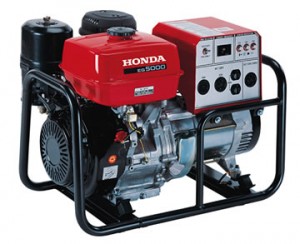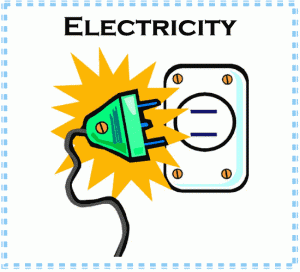By Guest Author, Ted Blanchard
 I confess. A generator is not one of my chosen tools for preparedness. But then again, I tend to prepare more for a serious survival scenario i.e.: a widespread national crisis, in which case I feel that a generator is useless and simply paints you as a target of the morally deficit and desperate individuals. However, in the event of a more temporary power outage scenario due to a hurricane, snow storm or such, a generator would certainly be a worthwhile tool to have. As such, I have solicited the assistance of Ted Blanchard, last week’s guest author to provide for us a 3 part series on understanding, protecting, and utilizing a generator. So here is part 1.
I confess. A generator is not one of my chosen tools for preparedness. But then again, I tend to prepare more for a serious survival scenario i.e.: a widespread national crisis, in which case I feel that a generator is useless and simply paints you as a target of the morally deficit and desperate individuals. However, in the event of a more temporary power outage scenario due to a hurricane, snow storm or such, a generator would certainly be a worthwhile tool to have. As such, I have solicited the assistance of Ted Blanchard, last week’s guest author to provide for us a 3 part series on understanding, protecting, and utilizing a generator. So here is part 1.
Power and Sizing of a Generator
We’ll start with an easy topic. Power is the ability to do work, plain and simple. It can be measured in horsepower (HP), watts (W) and a variety of other units. For the moment, we will focus on horsepower and watts. Electrical power (in watts) is the voltage times the current or 1Watt = 1Volt x 1Amp. In most houses a 75-watt bulb consumes about 0.625 amps, because US homes are almost all 120 volts AC (alternating current). 75W/120V = 0.625 amps of current passing through the bulb’s filament. You can think of voltage as electrical “pressure” and current as electrical “volume” if you need to wrap your mind around the details. Higher voltage “pushes” harder through any electrical load, including you if you are not careful, and higher current means more “juice” delivered to the hair dryer or overhead lights.
For convenience in comparing generators, we can also use kilowatts or kW, which is simply one thousand watts. If you want all the details click on watts, but for our purposes, one horsepower is a bit less than 750 Watts, or 0.75 kW of electrical power. For this reason, you can dismiss as falsehood any claims by a manufacturer that their 8 HP generator provides 10 kW of electrical power. A system’s Efficiency Factor – a number between 0 and 1, and often expressed as a percentage from 0% to 100% – is a measure of the efficiency of the system. A generator with an efficiency factor of 0.8 (or 80%) converts eight tenths of the power developed by the engine into available electrical power, on a continuous basis, to run lights, heaters, appliances and other household items. The rest is lost through engine heat, radiated sound and radio frequency (RF) energy and other “inefficiencies” of the generator. As a result, a fair “rule of thumb” is that a generator can be expected to provide roughly 600 to 700 watts of electrical power per engine horsepower, with 700 being an extremely efficient generator, bordering on impossible.
So we have already arrived at Warning One: check the math in the advertisement and if they are claiming an electrical power level that the specified engine simply cannot produce, ignore the nice low price and look elsewhere. As an example, I saw an ad for a generator allegedly rated at 8 kW continuous and 10kW peak, driven by a 9 HP engine. Simple math tells me that 9 HP x 0.7 kW per HP –>6.3kW absolute maximum available continuous power. “Peak power” is the rating that tells how much power the generator can provide very briefly during the first few milliseconds that a load such as a large motor or compressor needs to start up. Examples might be found in your freezer or a furnace blower. If they normally consume 1000 watts, they may actually require 1500 or more watts while they start from zero and approach their normal operating state. Such power levels can be attained briefly because of inertia in the generator’s engine and the generators ability to handle loads above the normal rating for a short period until the peak load brings the generator/engine system speed below normal – at which point you have a “brownout” for all loads connected to the generator. If the spin up time is short enough, you probably won’t even notice the disruption. This dual rating is why you often see generators listed with two numbers, such as 5kW/6kW. Those are the continuous and peak power ratings. Be wary of sellers who list a single number. They may be indicating the peak power and hoping you think it’s the continuous power available.
 What size generator do you need?
What size generator do you need?
This can be determined in a couple ways. The hard way is to add up the watts used by all your home devices and figuring out some sort of nominal percentage that represents the amount that may be on at a given high-usage time. A much simpler way is to take your electrical power bill, divide the number of kilo-watt hours (kWH or KWH) consumed in a month by 720 (the number of hours in a 30 day month) and apply a “loading” factor of anywhere between 3 and 7 which takes into account the fact that there is not much electrical demand during the night and so a straight average will give you a much lower number than what you require during active periods. Using a loading factor of 3 would require you to very carefully manage the household’s electrical consumption to avoid loading down your generator, but it can be done. A loading factor of 7 (or higher if so inclined and if you have the finances to allow it) lets you to pretty much live as usual without fear of placing too large a load on your generator.
Here’s an example from my own bill last month. I used 1060 KWH of power over the 30-day span. A straight average would say that I consumed 1.47 kW continuously, but if I relied on a 1.5 kW generator to meet my needs, I would be terribly disappointed, to say the least. In reality, I use a 10kW/12.5kW diesel fueled military surplus generator to power my home when our utility provider is down, for whatever reason. I don’t have to “ration” my usage and my generator hums along happily, never missing a beat. Could I get by with a 7.5kW generator? Sure, and I did so for 3 years, but switched over to the current arrangement for reasons explained in later paragraphs.
Most generators use fuel at a rate that follows the power loading, so if you get a 10kW generator but have household electrical items operating that only consume a total of 3kW it will get much better “mileage” than if you put a full 10kW load on it. Again, the fuel consumption is not linear with load, so try asking sellers what the consumption is at 100%, 75% and 50% loads. Be wary if they give numbers that too closely match 100%, 75% and 50% of the max fuel consumption. It should not be an exactly linear relationship due to the “inefficiencies” described earlier, which are near constant regardless of the power load.
 Now, briefly venturing into the technical realm again, we must consider the frequency of the power generated. North American homes run on 60-cycle or 60 Hz power. Many European homes run on 50 Hz. Ours is convenient because there are 60 seconds in a minute, and 60 minutes in an hour. Analog clocks (those are the ones with the moving hour, minute and second hands for those who have forgotten) maintain their accuracy because the power coming into your home is 60 Hz. The motor simply runs at a multiple of the power frequency and as a result your analog clock is as accurate as the control circuitry at the power generation plant that provides your power. As a kid, we marveled at how the “new” digital clocks always seemed to need adjustment, but the old sweep hand clock in the kitchen stayed right on the money for years, unless the power was interrupted. Digital clocks mostly use internal oscillators as the basis for their time standard and often that oscillator is ever so slightly fast or slow compared to a true 60 Hz.
Now, briefly venturing into the technical realm again, we must consider the frequency of the power generated. North American homes run on 60-cycle or 60 Hz power. Many European homes run on 50 Hz. Ours is convenient because there are 60 seconds in a minute, and 60 minutes in an hour. Analog clocks (those are the ones with the moving hour, minute and second hands for those who have forgotten) maintain their accuracy because the power coming into your home is 60 Hz. The motor simply runs at a multiple of the power frequency and as a result your analog clock is as accurate as the control circuitry at the power generation plant that provides your power. As a kid, we marveled at how the “new” digital clocks always seemed to need adjustment, but the old sweep hand clock in the kitchen stayed right on the money for years, unless the power was interrupted. Digital clocks mostly use internal oscillators as the basis for their time standard and often that oscillator is ever so slightly fast or slow compared to a true 60 Hz.
Any generator worth owning has an engine that runs at a multiple of 60 Hz, but we call it revolutions per minute (RPM) since the crankshaft is spinning in a circle. Most of the very good backup generators run at 1800 RPM, which is just our clocks’ favorite frequency multiplied by 30. It’s fairly easy to “divide down” and have the output power delivered at a constant 60 Hz. Some generators run at 3600 RPM, which is 60 times our reference frequency. There is nothing at all wrong with that, but consider the following: an engine’s noise level is usually related to the RPMs. Rev your car and it gets louder. Also, each revolution of your engine results in a tiny amount of operational wear on the moving parts. Not surprisingly, an engine designed to operate at 1800 RPM will generally last longer than one designed to run at 3600 RPM.
The life span is not necessarily linear, however, meaning that an engine running at half the speed does not last exactly twice as long. In diesel engines, for instance, a designed operational speed of 1800 RPM usually means a lifespan that is 5 to 20 times greater than one designed to run at 3600 RPM. The slower engine also usually runs quieter, though for higher speed engines sound attenuating materials can be used, usually at additional cost. At the risk of getting ahead of myself, diesel generator engines built by high quality manufacturers (such as Onan, Detroit Diesel, Caterpillar, and Cummins) which are designed to run at 1800 RPM will generally give you upwards of 20,000 hours of run time before requiring major repair or overhaul. That’s well over 2 years of non-stop use. Gasoline or diesel engines from inexpensive sources (mostly Chinese firms) and built to run at 3600 RPM typically give between 1,000 and 1,500 hours of service before some significant amount of repair or overhaul work is required. So we have reached WARNING TWO: don’t go cheap on something that may save your bacon down the road. Saving a few hundred dollars now could make for some very uncomfortable days and nights if we should ever have grid power issues spanning many weeks or even months. For a little light reading on that look up EMP and ponder for a while, the likely results of such an event. And as an aside, those cheap Chinese generators (gasoline or diesel) have lots of poor quality electronics that are very vulnerable to an EMP. Expensive electronics can be fried too, but they might at least have a decent protective housing that helps to shunt pulse energy to ground.
To be continued…
Back Up Power Generators Part II
Back Up Power Generators Part III



7 Comments
FernWise · December 29, 2009 at 6:18 pm
We have a home-based electronics business. If we don’t have electricity we can’t bring in money. So we have a small generator, bought from an old neighbor, to run the laboratory equipment and computers when power is down. We don’t use it for ‘small’ outages of a few hours, but after hurricanes or ice storms power can be down for a week or more here.
Neighbors seem to run generators immediately when power goes out. Seems silly to me – my fridge and freezer stay cold for hours and days, respectively, I have a hand crank radio for updates, and I can hang in there without air conditioning or fans for at least a while (depending on how active my hot flashes are at the time!).
Laurie · December 29, 2009 at 7:07 pm
We have a “whole house” generator that while doesn’t work everything, there are parts of the house that WILL work when it is running. We would never keep it on continually though if there was a power outage like and ice storm or snow storm. We would only use it for an hour in the morning and an hour in the evening so we could shower, do a load of wash, vacuum, etc. and then shut it down. Who would want to pay for the propane or gasoline to keep it running continously? Like Fernwise stated above…. Freezers and refrigerators will last a long time between cycles. I would rather have just an hour or two every 24 hours for a long period of time than 24 hours for a few days. Just my humble opinion.
Elizabeth · December 30, 2009 at 12:31 am
<< . . .national crisis, in which case I feel that a generator is useless and simply paints you as a target of the morally deficit and desperate individuals . . . "
Hooray! Finally, someone (Kellene) has given me permission to not feel like a total loser because I don't want or really need a generator. Everything you read talks about generators, but in my heart, I know it is not necessary for my situation. I live far south in the mildest climate you can think of. There are only 2 seasons, long, hot summer and the other few days. It is practically a year-round growing season, far enough from the hurricane coast, not prone to tornadoes, never snow or ice. If it really gets cold, we'll burn a fire in the fireplace. We have plenty of candles, flashlights, etc.
Thank you for releasing me to keep on without a generator. I do know they are essential in many parts of the country, just not mine.
Ted Blanchard · December 30, 2009 at 4:46 pm
I did not mean to give the impression that continuous operation of a generator is the norm. We occasionally have multi-day power outages here and even then we only run the generator for a few hours morning and evening to keep frozen/fridged food safe, top off all items that are on rechargeable batteries, and allow for the use of washer/dryer. Continuous use would be expensive and wasteful, and could potentially draw unwanted visitors in certain scenarios. For us, the value of the generator is in helping to preserve expensive food that might be ruined if left to thaw, to provide some creature comforts for morale, and to enable use of the most efficient form of heating (central heat with an electrically driven blower) during winter when outside temps can be in the below-zero range. –Ted
EKay · March 7, 2010 at 9:20 pm
I wondered if I could use this article and link it to your website in my ward info for the month – many of us are wondering how to choose a generator, and this was a great article! Can I have your permission to use it?
Kellene · March 7, 2010 at 9:27 pm
EKay, yes, you may but only because I was not the sole author, and the priamary author has given permission for others to benefit from it. However, my other articles, you would need to simply redirect them to the website.
Mamarama · April 5, 2012 at 2:31 pm
We have just started looking into the Yamaha Hybrid Generators and think it would work for us and what we want. We too suffer from “outages” which stop our Well Pump which means NO FLUSHING unless we use back up water. We have started keeping our camping trailer full of water and back-up supplies also, just in case we need to leave.
Comments are closed.